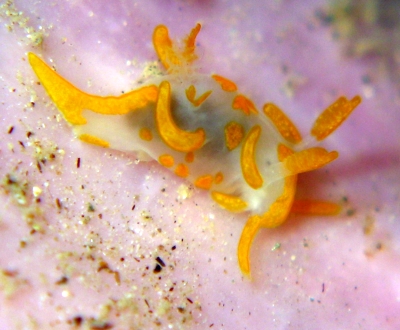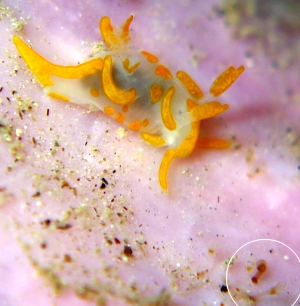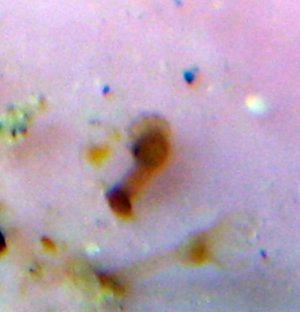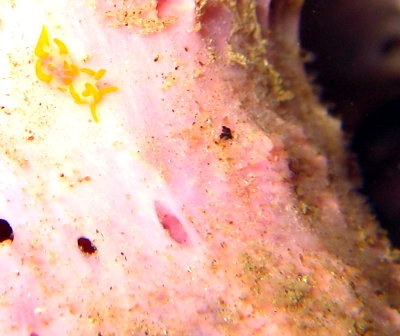Feeding Trapania maculata from the Mediterranean
December 12, 2008
From: Dominique Horst

Hello Bill,
I've found Trapania maculata for the first time. It seems that it is feeding on the sponge Dysidea (probably D. variabilis). Do they feed exclusively on entoprocts? In the picture, the dark part inside should be entoprocts ?
But does it means they are unable to feed on any sponge?
Locality: Cannes, 28 m, France, Mediterranean sea, 29 November 2008. Length: 5 mm. Photographer: Dominique Horst.
Many thanks and regards,
Dom.
dominique.horst@wanadoo.fr



Dear Dom,
As I have discussed elsewhere on the Forum, species of Trapania were for a long time considered to be sponge feeders, because they were usually found on certain sponges. However if we look at their radular teeth, we find that they are quite different from the teeth of other sponge feeders. We now have good evidence from photographs on the Forum that many species of Trapania feed on species of kamptozoa [entoprocts] which grow on these sponges. I have looked carefully at your photos and found two kamptozoan animals in the bottom right corner of one. I have included a close-up. Also, in the photo alongside my comments, I can see a 'furry' covering over the right edge of the sponge colony. I wouldn't be surprised if that was an aggregation of kamptozoans as well. This is the first direct evidence on the Forum of T. maculata associating with kamptozoans.
You can sometimes see one or two black spots inside the body of the kamptozoan individuals. These spots are the waste products inside the gut of the kamptozoans - in fact it is often the only clue I can see in photos that the blurry cover over some sponges is in fact kamptozoans. Concerning the black mass in the Trapania, that is the colour of the nudibranch's digestive gland. In most molluscs it is a dark brown to black colour. The digestive gland is a unique molluscan organ which produces digestive enzymes, absorbs and digests food, and excretes wastes.
As to whether any species of Trapania eats sponge. My personal feeling is that I am sure they don't, but since we don't have evidence for all species all I can say is that there is no direct evidence that they do and a lot to say they feed on kamptozoans that live on sponges. The more we investigate, the more evidence is accumulating to show that nudibranchs are often very specialised feeders, some species feeding on only one food species. It also appears that in most cases, food choice is linked to phylogenetic relationships - that is closely related species will eat the same or similar food items. We find similar food specialisation in many invertebrate groups. For example, the caterpillar larvae of many butterflies and moths will only feed on only one or two species of plants.
Best wishes,
Bill Rudman
Related messages
-
Re: Trapania maculata with eggs
From: Dominique Horst, February 26, 2009 -
Trapania maculata with eggs
From: Dominique Horst, February 24, 2009 -
Re: Feeding Trapania maculata from the Mediterranean
From: Dominique Horst, December 16, 2008 -
Re: Feeding Trapania maculata from the Mediterranean
From: Juan Lucas Cervera, December 16, 2008 -
Nudibranchs from the Aegean sea
From: Haluk Akbatur, November 20, 2002 -
Trapania maculata from the Mediterranean
From: Marina Poddubetskaia, July 30, 2002 -
Trapania maculata from Turkey
From: Baki Yokes, September 26, 2001 -
Re: origin of Trapania
From: Bernard Picton, May 1, 2001 -
Re: origin of Trapania
From: Miquel Pontes, April 29, 2001 -
Trapania maculata from Spain
From: Miquel Pontes, April 26, 2001 -
Trapania maculata from England
From: Bernard Picton , February 12, 2001
